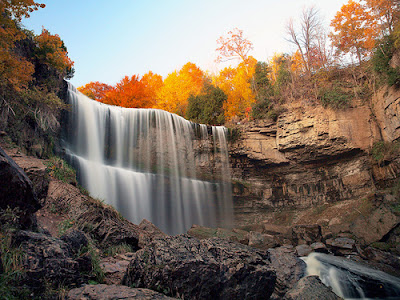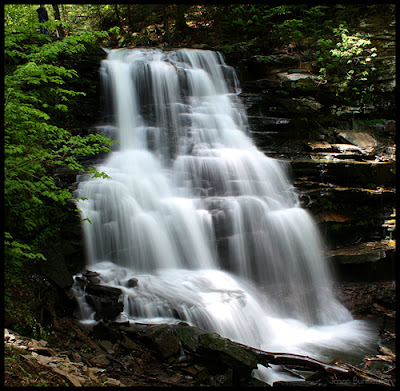Water has the natural power to draw human interest. It is more so in case of running water. I am not sure as to what is it that lures people to waterfalls, it might be the display of awesome force by nature or may be the feel of the mist and roar of the water hitting hard against the rocks. Whatever the reason may be waterfalls are one of the most photographed subjects on earth. Let us discuss a few tips and tricks to take waterfall photos that capture its essence and spirit.
 |
| Photo By Paul |
When to Photograph a Waterfall
When it comes to photographing waterfalls you should not only consider the time of the day but also the season of the year.
The best time is during sunrise and sunsets. The reason is that water reflects a lot of light and waterfalls are usually found in woods. Meaning during midday there will be sharp shadows and patches of very bright and very dark areas in your shot making it hard to reach a good exposure setting. I would suggest shooting during sunrise and one major reason is that the general area will be devoid of people especially tourists.
The best time of year to shoot any waterfall depends on the source of water that feeds the waterfall. You need to photograph the waterfall exactly when it has the right amount of water flowing. By this I do not mean to shoot it during the rainy season. Our aim is not to shoot when there is maximum water flowing, but to shoot when there is right amount of water flowing for the shot you envisioned.
Right Equipment to Shoot Waterfalls
My list of preferred equipments to shoot waterfalls are
- Wide angle zoom lens
- A Sturdy Tripod
- Cable / Wireless Shutter Release
- Polarizing Filter
- ND Filter
- Rain Protection Gear
Waterfalls are usually found in tight canyons or in difficult locations where there is not much room to move around to compose your shot. So a wide angle zoom lens could do the job most of the time. Since you need low shutter speeds and high aperture values a sturdy tripod and cable / wireless release combination is a must. Polarizing filters help you reduce the glare and eliminate reflections and also has the advantage of saturating colours of trees or foliage found around the waterfall. It also helps reduce the f stop by a couple of points. Although not utterly necessary an ND filter could help you reduce the light. It could save your day when you have to shoot a waterfall during midday. It may / may not rain but the general area around the waterfall would definitely have airborne water particles and it is best you carry rain protection gear for your camera and lenses.
ISO
Use the lowest possible ISO settings for your camera to photograph waterfalls. You will get the slowest shutter speed and the noise in the image will be minimum.
Aperture
There are two things to consider when choosing aperture for photographing waterfalls. You need the whole of the frame to be in focus and you need to obtain slow shutter speeds to create the smooth silky flowing effect to the water. So the answer is simple use high aperture values something greater than f / 16 should be fine.
 |
| Photo By Jason |
Shutter speed
The most important factor in a waterfall photo shoot is shutter speed. Slower shutter speeds could control the amount of blur caused by the running water producing a soft, artistic effect try experimenting with shutter speeds ranging from half a second to up to 3 seconds. And faster shutter speeds could freeze the motion capturing the scene as it is.
 |
| Photo By Lauri Vain |
Watch the Wind
Watch out for wind while photographing waterfalls at very slow shutter speeds as it could make other objects in your frame like branches of trees, grass etc. to move and get blurred.
 |
| Photo By Nicholas |
Metering
To get the right exposure settings it is crucial to select the right area as sample. Shift your camera to spot metering mode. There might be dark areas in your frame and very bright areas (water) choose some object that is in the frame that is middle grey like rocks or tree trunks and take your metering from them. Make sure that the object on which you are metering receives the same amount of light as the flowing water.
 |
| Photo By Sean Mc Grath |
Composition
You could either compose your frame with the entire waterfall or include the surrounding area and make waterfall just a part of the scene. Both are equally appealing concepts. When composing for the entire waterfall look out for objects or shapes that are distracting and find ways to eliminate them from the scene. Look out for good vantage points from which you could cover the entire waterfall without any distractions. Focusing on a small area of the waterfall like water falling on a rock or a group of rocks etc makes interesting elements for photographic composition. Make sure you include some foreground elements too like rocks, leaves, flowers, grass etc.
 |
| Photo By Wwarby |
Try shooting the waterfall from an angle rather than shooting directly from the front.
Waterfalls are beautiful to look at but up close they are also very dangerous. It is good to get great pictures, but no picture is worth risking your life. Waterfalls are slippery places and take extreme care while moving around. Always be aware of what is happening around you and where you are placing your foot. Do not move while looking through the viewfinder.
In the next article we will discuss about Photography - Nature and Wildlife Photography - How to Photograph Sunsets
A Word of Caution
Waterfalls are beautiful to look at but up close they are also very dangerous. It is good to get great pictures, but no picture is worth risking your life. Waterfalls are slippery places and take extreme care while moving around. Always be aware of what is happening around you and where you are placing your foot. Do not move while looking through the viewfinder.
In the next article we will discuss about Photography - Nature and Wildlife Photography - How to Photograph Sunsets
Post a Comment